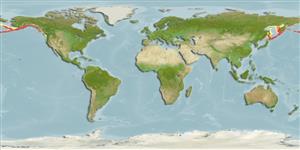Environment: milieu / climate zone / depth range / distribution range
Ekologi
marina djupbottenlevande; djupintervall 76 - 760 m (Ref. 80505). Deep-water
Northern Pacific: Kronotskiy Bay on the southeastern Kamchatka Peninsula through the Bering Sea, Commander and Aleutian Islands, and Gulf of Alaska to the Strait of Georgia and Puget Sound. Records from the Sea of Okhotsk are questionable.
Size / Vikt / Age
Maturity: Lm ? range ? - ? cm
Max length : 35.6 cm SL hane/ej könsbestämd; (Ref. 80505)
Short description
Bestämningsnycklar | Morfologi | Morfometri
Mjukstrålar i ryggfenan (totalt) : 102 - 114; Mjukstrålar i analfenan: 90 - 102; Ryggkotor: 109 - 122. This species is distinguished from L. diapterus in having scales on the nape, but not covering entire top of head to posterior margin of the orbits, usually extending anteriorly only to the occipital pores, and in having lower dorsal-fin ray (usually 111 or fewer), anal-fin ray (usually 101 or fewer), vertebral (usually 119 or fewer), and gill raker (usually 15 or fewer) counts. It differs from L. hubbsi in pectoral-fin ray count (18-21 vs. 20-23), in the position of first dorsal-fin pterygiophore (sixth or seventh interneural gap vs. third), and color pattern (L. beringi without narrow light bands extending onto dorsal fin and across nape). It differs from the L. nakamurae group in having 4 postorbital pores (vs. 1 or 2), the posteriormost without a short tube; rounded lower pectoral-fin lobe with tips of the rays rounded and the middle rays often branched, fin membrane not incised (vs. pointed, with rays pointed and unbranched, membrane moderately incised); scales usually present on base of pectoral fin; light inverted V-shaped bands usually present on body (Ref. 80505).
Life cycle and mating behavior
Maturities | Reproduktion | Spawnings | Egg(s) | Fecundities | Larver
Stevenson, D.E. and B.A. Sheiko, 2009. Clarification of the Lycodes diapterus species complex (Perciformes: Zoarcidae), with comments on the subgenus Furcimanus. Copeia 2009(1):125-137. (Ref. 80505)
IUCN Red List Status (Ref. 130435)
Threat to humans
Harmless
Human uses
Verktyg
Special reports
Download XML
Internet-källor
Estimates based on models
Preferred temperature (Ref.
123201): 1.1 - 5.9, mean 3.7 °C (based on 144 cells).
Phylogenetic diversity index (Ref.
82804): PD
50 = 0.5000 [Uniqueness, from 0.5 = low to 2.0 = high].
Bayesian length-weight: a=0.00120 (0.00057 - 0.00252), b=3.10 (2.91 - 3.29), in cm total length, based on LWR estimates for this (Sub)family-body shape (Ref.
93245).
Trofisk nivå (Ref.
69278): 3.4 ±0.5 se; based on size and trophs of closest relatives
Resiliens (Ref.
120179): Mycket låg, lägsta populationsfördubblingstid mer än 14 år (Preliminary K or Fecundity.).
Fishing Vulnerability (Ref.
59153): Low to moderate vulnerability (33 of 100).
